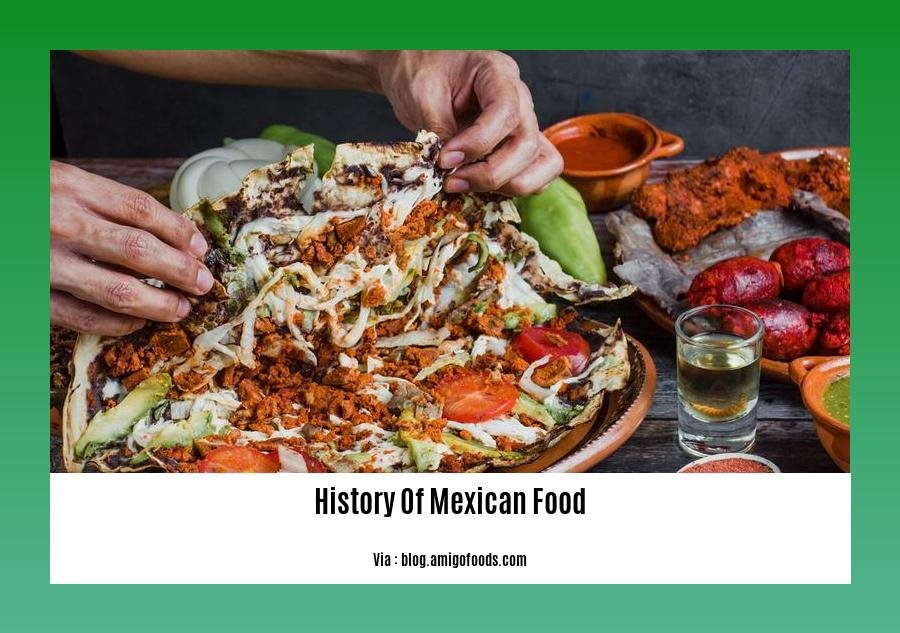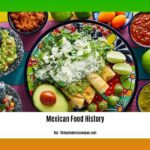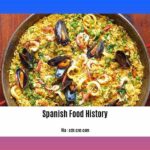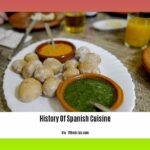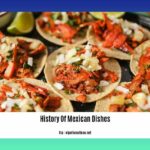Embark on a culinary journey through time as we delve into the rich history of Mexican food in “A Culinary Journey Through Time: Exploring the Rich History of Mexican Food”. From its humble pre-Hispanic origins to the colonial influences and modern-day innovations, Mexican cuisine is a vibrant tapestry of flavors, traditions, and cultural exchange. Join us as we uncover the secrets behind this beloved gastronomy and explore the diverse regional cuisines that make it a global treasure.
Key Takeaways:
Mexican cuisine is a harmonious blend of indigenous and Spanish influences that have evolved over time.
During the Mayan period, hunting and gathering formed the foundation of the cuisine.
The Aztec Empire’s rise in the 1300s introduced new staples, further shaping Mexican cuisine.
The Spanish conquest in the 1500s brought an influx of ingredients and cooking techniques, leading to a vibrant fusion of cultures.
Today, Mexican cuisine boasts a diverse range of traditional dishes, each showcasing unique flavors and ingredients, making it a beloved global culinary treasure.
History of Mexican Food
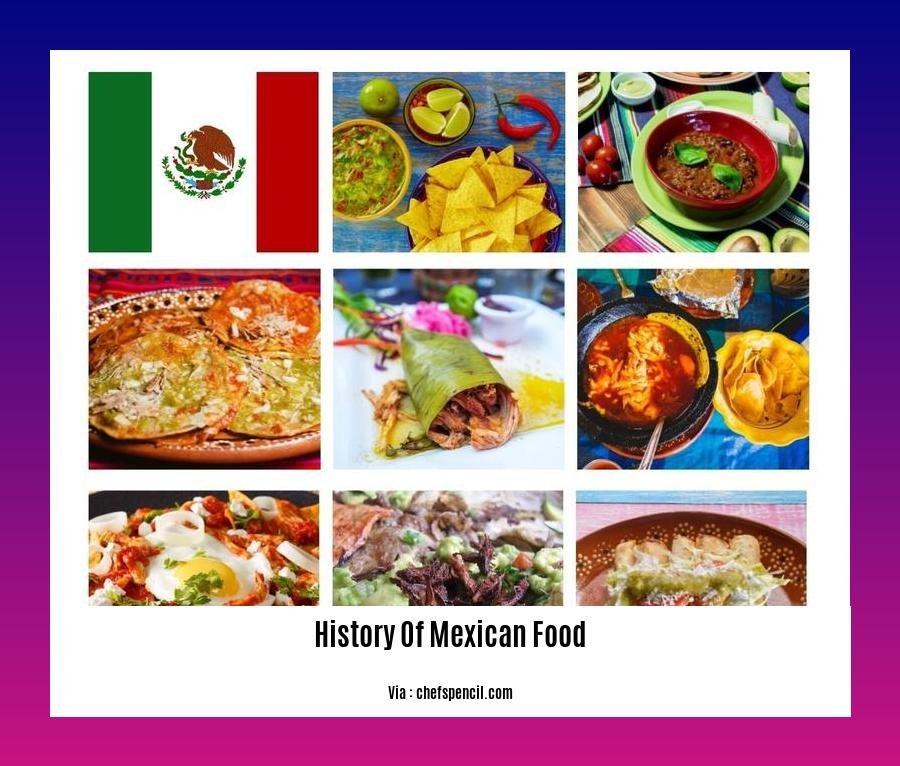
Mexican cuisine, a vibrant tapestry of flavors and textures, boasts a rich and diverse history deeply rooted in ancient civilizations, colonial influences, and modern innovations. Let’s embark on a culinary journey through time to explore the evolution of this beloved gastronomy.
Pre-Hispanic Foundations
Mexico’s culinary heritage finds its genesis in the diverse cultures that thrived in the region before the arrival of the Spanish. The ancient Maya, known for their sophisticated civilization, subsisted on a diet centered around hunting, gathering, and agriculture. Maize (corn) emerged as a staple crop, along with beans, squash, chili peppers, and tomatoes, forming the foundation of what would become the iconic flavors of Mexican cuisine.
The Aztec Empire’s Culinary Legacy
The Aztec Empire, which emerged in the 14th century, further shaped Mexican cuisine with the introduction of new ingredients and culinary techniques. The Aztecs cultivated a vast array of crops, including amaranth, chia seeds, and cacao, which were incorporated into their daily diet. They also developed elaborate cooking methods, such as nixtamalization, a process of treating corn with lime that enhances its nutritional value and flavor.
Spanish Influences and the Colonial Era
The arrival of the Spanish in the 16th century marked a turning point in Mexican cuisine. European ingredients, such as wheat, rice, and various spices, were introduced, blending with indigenous staples to create a unique fusion of flavors. Spanish cooking techniques, like frying and stewing, also influenced traditional Mexican dishes, giving rise to beloved creations like enchiladas, tacos, and tamales.
Modern Mexican Cuisine: A Culinary Symphony
Today, Mexican cuisine stands as a vibrant and dynamic culinary expression, reflecting the country’s rich history and cultural diversity. Regional variations abound, with each state showcasing its unique specialties. From the hearty barbacoa of the north to the seafood-rich cuisine of the coastal regions and the mole sauces of the central highlands, Mexican cuisine offers a symphony of flavors that captivate palates worldwide.
Mexican Food Timeline
| Era | Key Developments |
|---|---|
| Pre-Hispanic (Before 1519) | Maize, beans, squash, chili peppers, and tomatoes form the basis of the diet. |
| Aztec Empire (1325-1521) | Introduction of amaranth, chia seeds, cacao, and nixtamalization. |
| Colonial Era (1521-1821) | Spanish ingredients and cooking techniques are introduced, leading to a fusion of flavors. |
| Modern Era (1821-Present) | Regional variations flourish, and Mexican cuisine gains international recognition. |
Conclusion
The history of Mexican food is a testament to the enduring power of culinary traditions. From its ancient roots to modern-day innovations, Mexican cuisine continues to captivate hearts and taste buds worldwide, embodying the rich cultural heritage of a nation that embraces flavor, diversity, and culinary excellence.
Looking to explore the culinary journey of Mexico? Delve into the history of Mexican Cuisine and uncover the fascinating evolution of Mexican dishes, from ancient roots to the modern-day explosion of flavors. Or embark on a journey to discover the history of Mexican dishes, where each ingredient, each recipe tells a story of tradition, innovation, and cultural diversity. Don’t miss this chance to savor the rich tapestry of Mexican cuisine through the ages!
**Regional Diversity: A Celebration of Mexico’s Diverse Culinary Traditions**
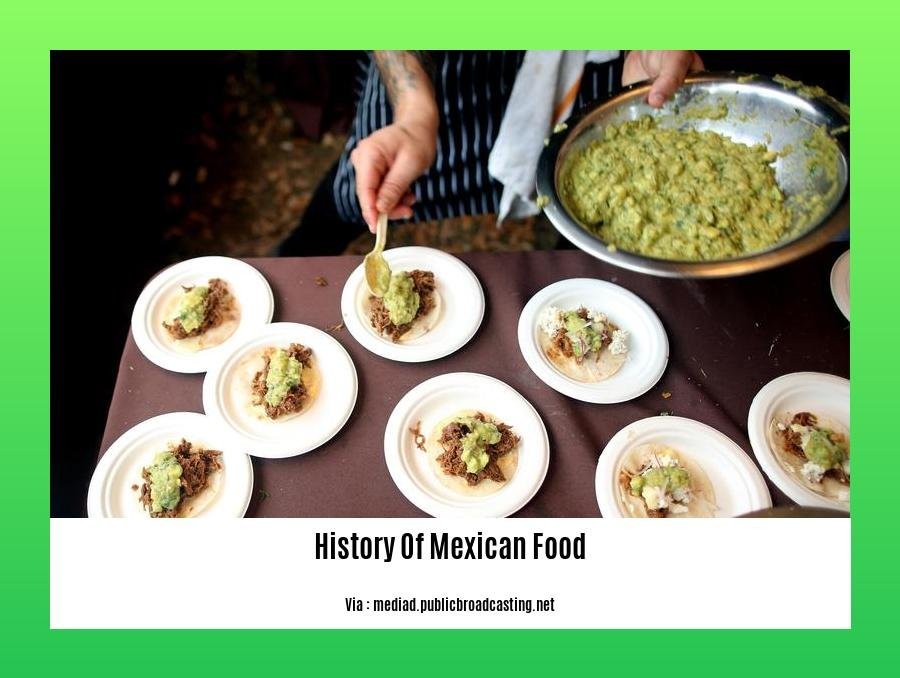
Mexico’s regional diversity is truly a culinary adventure, with each region boasting unique flavors and dishes that reflect their diverse geography, climate, and cultural influences. Join us as we embark on a culinary journey through Mexico’s culinary regions!
**Exploring the Gulf Coast’s Seafood Bounty**
The Gulf Coast, with its close proximity to the sea, is a haven for seafood lovers. Here, you’ll find an array of dishes that showcase the freshest catches of the day, from ceviche to seafood cocktails. Don’t miss the opportunity to savor the flavors of the sea in this region.
**Central Mexico: A Fusion of Indigenous and European Flavors**
Central Mexico, including Mexico City, is a melting pot of indigenous and European influences. This region is renowned for dishes like tamales, pozole, and barbacoa, which blend traditional ingredients with European cooking techniques. Experience the harmony of flavors that define this culinary region.
**Northern Delights: A Culinary Blend of Two Worlds**
In the north, the influence of neighboring states in the United States is evident in the use of corn and wheat. Here, you’ll find dishes like burritos and enchiladas, which have gained popularity and become emblematic of Mexican cuisine. Discover the unique culinary fusion that has emerged in this region.
**Pacific Coast: A Seafood Paradise with a Coastal Twist**
The Pacific Coast, with its vast coastline, offers an abundance of seafood, including fish, shrimp, and octopus. These treasures of the sea are often grilled or fried, resulting in dishes that capture the essence of the ocean. Indulge in the flavors of the Pacific in this culinary haven.
**Southern Flavors: Rooted in Indigenous Traditions**
The southern region of Mexico is deeply rooted in indigenous cultures, and its cuisine reflects this rich heritage. Here, you’ll find dishes like black bean soup and enchiladas, which showcase ingredients like beans, corn, and squash. Explore the authentic flavors of this region, where tradition meets taste.
**Key Takeaways:**
- Diverse Regions, Diverse Flavors: Mexico’s regional diversity is reflected in its cuisine, with each region offering unique dishes and flavors influenced by geography, climate, and culture.
- Seafood Delights: The Gulf Coast is a seafood paradise, with dishes like ceviche and seafood cocktails showcasing the bounty of the sea.
- Central Fusion: Central Mexico blends indigenous and European flavors, resulting in iconic dishes like tamales, pozole, and barbacoa.
- Northern Influences: The north showcases a culinary fusion, with dishes like burritos and enchiladas reflecting the influence of neighboring states in the United States.
- Pacific Coastal Cuisine: The Pacific Coast offers a variety of seafood dishes, grilled or fried to perfection, highlighting the region’s coastal heritage.
- Southern Traditions: The southern region of Mexico features dishes like black bean soup and enchiladas, rooted in indigenous cultures and showcasing traditional ingredients.
**Sources:**
Modern-day innovations: An examination of contemporary trends and innovations in Mexican cuisine, including the rise of celebrity chefs, fusion cuisine, and the globalization of Mexican food.
In the ever-evolving world of Mexican cuisine, innovation is the spice that keeps things sizzling. From the rise of celebrity chefs to the fusion of flavors and the global reach of Mexican food, let’s explore the modern trends that are shaping this culinary landscape.
Celebrity Chefs: The New Rockstars of the Kitchen
In the culinary world, celebrity chefs have become the rockstars of the kitchen, captivating audiences with their charisma and culinary prowess. These culinary maestros, like rockstars on a stage, command attention with their innovative dishes and larger-than-life personalities. They’re not just cooking; they’re creating edible masterpieces, inspiring home cooks, and revolutionizing the way we perceive Mexican food.
Fusion Cuisine: A Culinary Symphony of Flavors
Fusion cuisine, like a musical symphony, blends the best of different culinary traditions, creating harmonious dishes that burst with flavor. Mexican fusion cuisine, in particular, is a testament to the country’s rich culinary heritage, as it seamlessly merges本土ingredients and techniques with global flavors. From Asian-inspired tacos to European-influenced moles, fusion cuisine is a culinary adventure that takes taste buds on a global journey.
Globalization: Mexican Flavors Conquering the World
The globalization of Mexican food is a testament to its universal appeal. Like a contagious melody, Mexican cuisine has captivated taste buds worldwide, becoming a global phenomenon. From taco trucks in New York to enchilada stands in Tokyo, Mexican flavors have found a home in the hearts and stomachs of people across the globe. This culinary conquest is a tribute to the versatility and deliciousness of Mexican food, proving that its flavors transcend borders and cultures.
Key Takeaways:
- Celebrity chefs are revolutionizing Mexican cuisine with their innovative dishes and captivating personalities.
- Fusion cuisine blends本土ingredients and techniques with global flavors, creating a culinary symphony of tastes.
- Mexican food’s globalization is a testament to its universal appeal, conquering taste buds worldwide.
Sources:
- Mexican Cuisine: A History of Innovation and Fusion
- The Globalization of Mexican Food
Mexican Cuisine: A Global Treasure
Mexican cuisine as a global treasure: A reflection on the global recognition and appreciation of Mexican cuisine, its influence on international gastronomy, and its designation as UNESCO Intangible Cultural Heritage.
Over centuries, Mexican cuisine has captivated hearts and taste buds worldwide, earning its well-deserved recognition as a global treasure. Its rich tapestry of flavors, diverse ingredients, and unique cooking techniques have secured its place in the culinary pantheon.
A Culinary Symphony: History and Evolution
The culinary journey of Mexican cuisine began thousands of years ago with the indigenous civilizations that called this land home. The Maya, Aztecs, and other pre-Hispanic cultures laid the foundation for this extraordinary cuisine with their mastery of ingredients like maize, beans, squash, and chili peppers.
The arrival of the Spanish in the 16th century marked a significant turning point, introducing new ingredients and techniques that blended seamlessly with the existing culinary traditions. This fusion gave birth to iconic dishes like enchiladas, tacos, and tamales, which have become symbols of Mexican cuisine worldwide.
UNESCO’s Acknowledgement: A Culinary Milestone
In 2010, UNESCO bestowed upon Mexican cuisine the prestigious title of Intangible Cultural Heritage of Humanity. This recognition serves as a testament to the enduring power and global significance of this culinary tradition, highlighting its role in shaping cultural identity and community celebrations.
Global Influence: A Culinary Force
The influence of Mexican cuisine extends far beyond its borders, leaving an indelible mark on international gastronomy. Mexican flavors have permeated cuisines worldwide, from California to Tokyo, with dishes like burritos, tacos, and guacamole becoming beloved staples in kitchens and restaurants around the globe.
Mexican cuisine’s influence is not limited to food alone. It has also inspired culinary techniques, cooking styles, and even entire restaurants dedicated to celebrating its flavors. From trendy taquerias to high-end Mexican restaurants, the world has embraced the vibrant spirit of this culinary haven.
Key Takeaways:
Mexican cuisine is recognized as an Intangible Cultural Heritage of Humanity by UNESCO, a testament to its cultural significance.
The fusion of indigenous and Spanish culinary traditions has shaped the unique flavors and dishes that define Mexican cuisine.
Mexican cuisine has a global reach, influencing international gastronomy with its distinct flavors and iconic dishes like tacos and burritos.
The designation of Mexican cuisine as an Intangible Cultural Heritage highlights its role in shaping cultural identity and community celebrations.
Mexican cuisine continues to evolve and adapt, captivating taste buds worldwide with its vibrant flavors and culinary innovation.
Sources:
UNESCO – Intangible Heritage Home
Mexican gastronomy – a world intangible cultural heritage
FAQ
Q1: What were the primary influences on the development of Mexican cuisine?
A1: Mexican cuisine is a blend of indigenous and Spanish influences, with the Mayan period relying on hunting and gathering, the Aztec Empire introducing various staples, and the Spanish conquest bringing new ingredients and techniques.
Q2: How did the Spanish conquest impact Mexican cuisine?
A2: The Spanish conquest introduced new ingredients like wheat, dairy, and spices, as well as cooking techniques like frying and stewing, leading to a fusion of indigenous and European culinary traditions.
Q3: What are some of the most popular traditional Mexican dishes?
A3: Traditional Mexican dishes include tamales, pozole, barbacoa, ceviche, enchiladas, and burritos, each with its unique flavors and ingredients, reflecting the diverse regional cuisines of Mexico.
Q4: How is Mexican cuisine recognized internationally?
A4: Mexican cuisine was inscribed on UNESCO’s Representative List of the Intangible Cultural Heritage of Humanity in 2010, recognizing its cultural significance and the fusion of farming, ritual practices, culinary techniques, and community celebrations.
Q5: What makes Mexican cuisine unique and beloved worldwide?
A5: Mexican cuisine’s unique blend of indigenous and Spanish influences, coupled with its diverse regional variations, vibrant colors, and rich flavors, has made it a beloved cuisine globally, enjoyed for its culinary heritage and cultural significance.
